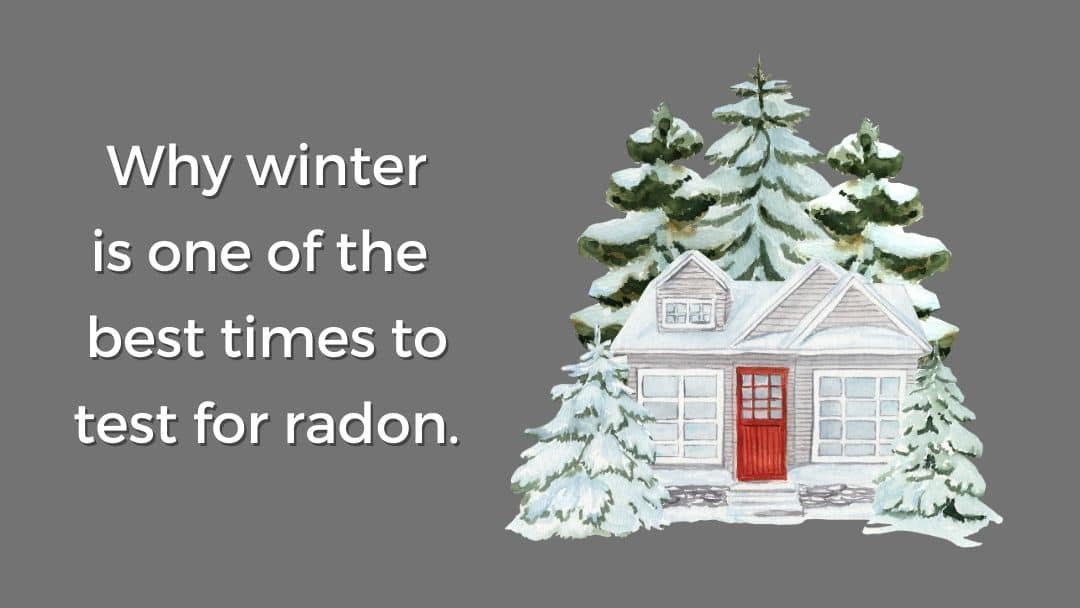
Introduction: Radon is an invisible and odorless radioactive gas that occurs naturally in our soil and releases into the atmosphere. In the outdoors, it disperses easily and generally isn’t a health issue. However, radon can seep into homes and accumulate to higher levels that are hazardous to one’s health, greatly increasing the chances of getting lung cancer. In fact, radon is the number one leading cause of lung cancer among non-smokers in America.1
Why Test for Radon in the Winter?
Radon can accumulate to higher levels inside the home, especially in the winter months when we tend to keep the windows closed. The lack of fresh air circulating within the home causes the indoor air to stagnate, allowing radon levels to increase and become more hazardous our health as it seeps indoors through the cracks in our home’s foundations and concrete floors.
The Stack Effect Increases Radon Levels
During the winter, the cold outdoor air tends to create a stronger natural vacuum on a home, pulling more warm indoor air out of the home through cracks in drafty windows, doors, and vents. This in turn causes a vacuum effect indoors. With the upper layers of indoor air pulled outside, the vacuum effect now pulls in air, and potentially more radon gas, from the ground level through cracks in the foundation. This stack effect is the major cause of radon entering a home.2

We Spend More Time Indoors
With the cold weather, we spend the majority of our time indoors which, believe it or not, greatly increases our exposure to air pollutants. According to the EPA, the levels of indoor air pollutants are often 2 to 5 times higher than outdoor levels.(3) So, this is another great reason to test for radon—you’ll learn what is the highest level of radon that can be affecting you and your family.
What is an Acceptable Level of Radon?
“Radon is measured in picoCuries per liter of air (pCi/L). Radon levels inside houses below 4 pCi/L are considered acceptable. If your home has radon levels above 4 pCi/L, you should take action.”
–U.S. Dept of Housing and Urban Development
The EPA Recommends Radon Testing Each Winter
In fact, the Environmental Protection Agency has designated January as National Radon Action Awareness Month. The organization and the U.S. Surgeon General recommend that all homes be tested for radon, as well as encourage everyone to spread the word about the health risks of radon. For details, visit the EPA National Radon Action Month webpage.
How You Can Test Your Home for Radon
There are a couple of ways you can test for radon. If you’re a Do-It-Yourself kind of individual, you can order a radon test kit on the California Department of Public Health, Indoor Radon Program webpage.
If you’d rather have the expertise, convenience, and peace of mind that comes with having trained radon professionals conduct the tests for you, feel free to contact Adviro Environmental Consulting and Testing today. To make an appointment, send us an email at info@goadviro.com or call (844) 607-9667. To learn more about radon testing, you can also visit our Radon webpage.
Did You Know?
Radon has been found in every county in California. This is why every Californian is encouraged to test their home for radon.
1 Environmental Protection Agency | https://www.epa.gov/radon/health-risk-radon#:~:text=Radon%20is%20the%20number%20one,people%20who%20have%20never%20smoked.
2 Environmental Protection Agency | https://www.epa.gov/sites/default/files/2014-08/documents/buildradonout.pdf
3 Environmental Protection Agency | https://www.epa.gov/report-environment/indoor-air-quality

Recent Comments